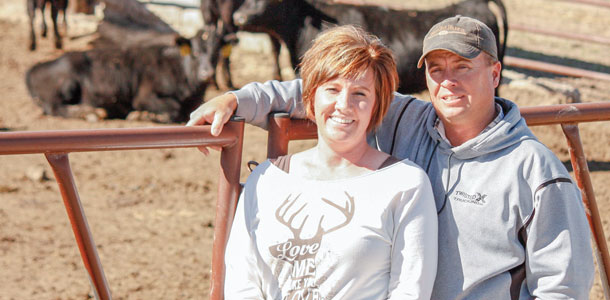 Their 2014 calves were the first commercially traded under the new Top Dollar Angus program.
Their 2014 calves were the first commercially traded under the new Top Dollar Angus program.
Those Hoot Owl steers earned $67 per head above average for weight and type that day on Superior Livestock Auction’s video sale.
“This is going to be a year where most people would look at this story and say, ‘Why? Why put all that effort into my steers when I could still make this much money on them?’ But it’s for the years when the market comes down – which it will – and we’ll still be able to be above-average,” Kenny says. “That’s when it’s really needed, and if you’re not already working on it now, you just missed out when you needed it most.”
Stauffer has spent the last decade meticulously tracking growth and maternal data on the commercial and registered Angus herd that grazes the panhandle’s Wildcat Hills, near Harrisburg, Nebraska.
Every calf on the place sees a scale at birth, weaning and sale day, tracking daily gain, weaning weight and mom’s percent of calf weaned. That’s matched with expected progeny differences (EPDs) for three critical traits on the sire side: growth, carcass and maternal.
“From the day that female is born until she leaves the herd, we’re tracking her,” he says.
With that, the Stauffers have amassed individual 10-year performance numbers on every one of more than 700 cows. That data came in handy when they went to qualify for Top Dollar Angus.
They had to prove two generations of sires and dams with an average of at least $80 in the Angus $Beef ($B) value, the dynamic market index that reports a combined value for feedlot and carcass merit.
 When Kenny learned about the third-party genetic certification program from its founder, Tom Brink, he had only to call up a report from those records.
When Kenny learned about the third-party genetic certification program from its founder, Tom Brink, he had only to call up a report from those records.
“We knew with that data, he would either want to buy our cattle or he would help us figure out what we could do better,” Misty says. “So there was a positive outcome for us either way.”
The Stauffers got both. Not only did they discover a new buyer willing to pay – literally – top dollar, they found a new benchmark for their herd’s data. A $B value of $80 or more puts animals in the top 25 percent of the Angus breed for gain and grade, and the Hoot Owl herd showed an $86 average across the board.
It takes both marbling and growth for success when calves leave the ranch, Brink says. After years of buying and tracking millions of cattle for Five Rivers Cattle Feeding, he says knowing the type that will make money is easy.
Identifying them, however, creates a challenge Top Dollar Angus was created to overcome.
Cattle earning large grid premiums have a few traits in common, he says: “They are exceptionally high for quality grade and capture added dollars for Certified Angus Beef brand (CAB) and prime.
“Dressing percentages are above the grid base; yield grade is near industry average. Furthermore, they have very few non-conforming carcasses, like dark cutters, or carcasses that are either too heavy or too light.”
While the Hoot Owl steers were the first auction-traded Top Dollar Angus cattle, by October, Brink had harvest data on 144 lots of other cattle in the program that tallied $100-plus per head on grids.
The 15,080 head graded off the charts: nearly 90 percent choice or higher, 43 percent CAB, 12 percent prime. They dressed 65 percent with 84 percent in yield grades 1 to 3. Altogether, they returned average premiums of $125.21 per head.
Estimating more than 70 percent of finished cattle sell on a grid or formula, Brink says profit-minded producers must prove they deserve a piece of that pie if they want feedlots to pass some of that premium back to them.
The day of “reputation blacks” has given way to what Brink calls “relationship cattle” – those that trade based on full knowledge.
“That’s the point of this whole program,” he says, “to put a name brand on those high-end Angus cattle and give the cattle feeder more assurance in what he’s getting so he’s willing to pay more.”
Sold directly to one of more than 35 partner feedyards, certified cattle are virtually guaranteed to get a $50-per-head premium or more. But Brink says, as Stauffer’s Superior sale shows, “We’ve got demand for these cattle. We’ve got more than a million head of demand at a premium price, and ultimately the market will figure out what that premium is.” ![]()
Laura Nelson is a writer for Certified Angus Beef.
PHOTOS
PHOTO 1: The Top Dollar Angus herd grazes the Nebraska panhandle’s Wildcat Hills.
PHOTO 2: Kenny and Misty Stauffer have collected 10 years of performance data on more than 700 cows.
PHOTO 3: Tom Brink. Photos courtesy of Certified Angus Beef.





